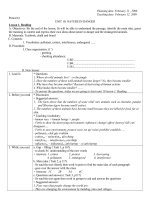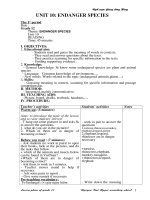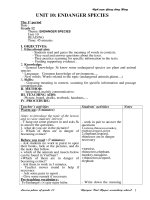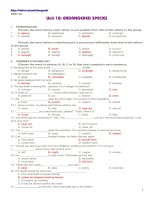unit 10 to 12
Bạn đang xem bản rút gọn của tài liệu. Xem và tải ngay bản đầy đủ của tài liệu tại đây (332.63 KB, 26 trang )
Planning date: February 11 , 2008
Teaching date: February 12, 2008
Period 61
UNIT 10: NATURE IN DANGER
Lesson 1. Reading
A. Objectives: By the end of the lesson, Ss will be able to understand the passage, identify the main idea, guess
the meaning in context and express their own ideas about nature in danger and the endangered animals.
B. Materials: Textbook, chalk and board
C. Contents:
1. Vocabulary: pollutant, extinct, interference, endangered …..
D. Procedure:
I. Class organization: (1’)
- greeting
- checking attendance:
11B2:....................................................................................
11B4:....................................................................................
11 B1.....................................................................................
II. New lesson:
1. Lead in * Questions:
1. Where do wild animals live? – in the jungle
2. Have the numbers of these wild animals become larger? No, they become smaller
3. Why have they become smaller? Because of destroying of human actions
4. What makes them become smaller? ……
- To answer the questions, today we are going to learn unit 10 lesson 1. Reading
2. Before you read * Discussion:
+ Suggested answers:
1. The facts above that the numbers of some wild/ rare animals such as cheetahs, pandas
and Siberian tigers become small/ extinct.
2. The numbers of these animals have become small because they are killed for food, fur or
skin.
* Teaching vocabulary:
- human race = human beings = people
- Verbs to show the destroying environment: influence/ change/ affect/ destroy/ kill/ cut/
disappear….
- Verbs to save environment: protect/ save/ set up/ raise/ prohibit/ establish ….
- pollutant
(n)
chất gây ô nhiễm
- extinct
(a)
– extinction
(n)
tiệt chủng
- interfere
(v)
– interference
(n)
can thiệp
- influence
(n)
– influential
(a)
ảnh hưởng – có ảnh hưởng
3. While you read a. Gap – filling ( Task 1, p 167)
- to check Ss’ understanding of the new words
+ Answers: 1. extinct 2. protect 3. decreasing
4. pollutants 5. endangered 6. interference
b. Main idea ( Task 2, p 117)
- Ss read the text silently then work in pairs to find the main idea of each paragraph
- goes over the answer with the class
+ Answers: 1C 2B 3A 4C
c. Questions and answers ( Task 3, p117)
- Ss read the text again then work in groups to ask and answer the questions
+ Suggested answers:
1. Four ways that people change the world are:
- They are changing the environment by building cities and villages.
- They are affecting the water supply by using water for industry and agriculture.
- They are changing weather conditions by cutting down trees in the forests.
- They are destroying the air by adding pollutants like smoke from factories and fumes from
cars
2. The serious consequences of people’s interference with the environment are:
- many kinds of rare animals are killed
- the environment where these animals are living is badly destroyed.
- the numbers of rare animals are decreasing so rapidly that they are in danger of becoming
extinct.
3. Many things have been done to protect endangered nature, such as:
- many organizations have been set up and money has been raised to save rare animals.
- thousands of national parks have been established.
- laws have been passed to prohibit killing endangered animals
4. After you read - groups work to find out why some animals have become extinct.
+ Suggested answers:
- People kill animals for fur, skin and food
- People keep animals as pets
- People hunt or capture animals for recreation or entertainment.
5. Homework - learn the new words by heart and reread the text then translate into Vietnamese
- prepare speaking lesson.
----------------------------------------------***------------------------------------------------
Planning date: February 12 , 2008
Teaching date: February 13, 2008
Period 62
UNIT 10: NATURE IN DANGER
Lesson 2. Speaking
A. Objectives: By the end of the lesson, Ss will be able to talk about endnagered nature and express their own
ideas about measures for protecting endangered nature.
B. Materials: Textbook, chalk and board
C. Contents:
1. Vocabulary: pollutant, extinct, interference, endangered …..
D. Procedure:
I. Class organization: (1’)
- greeting
- checking attendance:
11B2:....................................................................................
11B4:....................................................................................
11 B1.....................................................................................
II. Checking old lesson: ( New words and read the text)
III. New lesson:
1. Lead in - Today’s lesson we will talk about endangered nature and measures for protecting
endangered nature.
2. Before you speak * Teaching vocabulary:
- cultivation
(n)
sự cày cấy, sự trồng trọt
- Discharge
(v)
thải ra
- discourage
(v)
thuyết phục ai không làm gì
- capture
(v)
bắt giam
3. While you speak a. Brainstorming ( Task 1, p118)
- Ss say their ideas about the reasons why nature is threatened in their group first.
Ex: What do you think is the most important reason?
- In my opinion, the most important thing is ………….
b. Matching ( Task 2, 118)
- Ss work in pairs to match the reasons in task 1 with possible measures for protecting the
environment in task 2 as following the table
Reasons why nature is threatened
- killing endangered animals for fur,
skin and food.
- keeping animals as pets
- burning the forests/ cutting down
trees for wood
- using fertilizers and pesticides for
cultivation
- discharging chemical pollutants into
the environment
Measures for protecting endangered
nature
- killing endangered animals for fur, skin
and food should be banned
- keeping animals as pets should be
discouraged
- planting trees should be encouraged
- we should decrease the use of fertilizers
and pesticides for farming.
- discharging chemical pollutants into the
environment should be prohibited
4. After you speak * Making conversation ( Task 3, p118)
- asks Ss to make a conversation, using the passive voice of should to combine the ideas in
activity 1 with activity 2
+ Sample conversation
S1: Do you know these days people are cutting down a lot of trees in the forests for wood?
S2: Yes, I think laws should be introduced to stop people from cutting trees for wood.
S1. You are right and planting trees should be encouraged
S2. Yeah ….
- Ss work in pairs to do the same
- calls on some pairs to front of the class to act out their conversation
5. Homework - find more information about endangered animals
- prepare listening lesson
-------------------------------------------------------***-------------------------------------------------------------
Planning date: February 13 , 2008
Teaching date: February 14, 2008
Period 63
UNIT 10: NATURE IN DANGER
Lesson 3. Listening
A. Objectives: By the end of the lesson, Ss will be able to listen and understand the general ideas and pick up the
specific ideas.
B. Materials: Textbook, chalk and board
C. Contents:
1. Vocabulary: scenic features, devastating, maintenance, approximately ……
D. Procedure:
I. Class organization: (1’)
- greeting
- checking attendance:
11B2:....................................................................................
11B4:....................................................................................
11 B1.....................................................................................
II. New lesson:
1. Warm up * Game: Guessing word ( Two words)
- - - - - - - - - - - -
1 2 3 4 5 6 7 8 1 2 3 4
+ Suggested: It’s a place where many visitors who are interested in nature like to visit
It’s a place where there are a lot of forests, caves, rivers, plants, wild animals
It’s is known as Cuc Phuong, Cat Ba …..
+ Key: NATIONAL PARK
- What national parks in Vietnam and in the world do you know?
- Why have many national parks in the world been founded?
- Can you tell me some danger these national parks can face with?
To know the answer, today you are going to listen to a text about national parks in the
United States.
2. Before you listen * Teaching vocabulary
- scenic features: đặc trưng về thiên nhiên xinh đẹp
- devastating: tàn phá
- maintain
(v)
– maintenance
(n)
– maintainable
(a)
bảo trì, gìn giữ - sự bảo trì – có thể bảo trì
- helps Ss to pronounce
3. While you listen a. Task 1, p119: True or False statement
- asks Ss to read all the statements and guess if they are true or false.
- You are going to hear someone talking about National parks in the States. Listen to my
tape. Then tick the true or false sentences.
* Tapescript:
In many part of the United States, large areas of land have been made into national
parks to protect and preserve the natural beauty of the land. National parks usually contain
variety of scenic features, such as mountain, caves, lakes, rare animals and plants. Today
there are 52 national parks in the United States, covering approximately 3 percent of the
total land area of the country. National parks are all open to the public and have millions
of visitors each year.
Many national parks, however, are in danger of being destroyed. Rare animals in
antional parks are killed ar hunted for fur, skin or other parts. Trees are cut down for
wood. Large areas of national parks also experience devastating fires caused by careless
people. The increasing number of visitors is harming the parks due to the pollution from
their vehicles.
If these problems are not solved immediately, and if there is not enough money for
the parks staff and maintenance of their resources, many national parks will be completely
destroyed.
+ Answers:
1T 2T 3F 4T 5T
b. Task 2 : Multiple choice (handouts)
- asks Ss to read all the questions and guess the answwers before listening
- Ss listen again and choose the correct answer
* Multiple choice
1. How many national parks are there in the United States?
a. 50 b. 52 c. 53 d. 55
2. How many people visit national parks every year?
a. five thousand b. three thousand c. millions of visitors d. billions of visitors
3. Can you mane some of the problems which national parks are currently facing?
a. Rare animals are killed or hunted for fur, skin or other parts.
b. Trees are cut down for wood.
c. Devastating fires are caused by careless people.
d. All are correct
4. What should be done to protect national parks?
a. Increase the number of visitors to earn more money for the parks.
b. These problems should be solved gradually.
c. Money should be raised for the park’s staff and maintenance of their sources.
d. If there is not enough money, some national parks should be destroyed.
4. After you listen * Discussion:
- asks Ss to work in groups of four to discuss these questions. A secretary from each group
will note down Ss’ideas.
1. Have you ever visited a national park in our country? Or Have you ever seen a national
park in Vietnam on TV?
2. What is there in the National park?
3. Does it have the same problems as the other national parks?
4. What should we do to protect our national parks and what shouldn’t we do to destroy
them?
- calls on one of representative of each group comes to the front of the class and presents
their ideas.
- asks Ss to give comments on each group
5. Homework Write a summary of the text basing on the information in task 1 and task 2
------------------------------------------------------------***------------------------------------------------------
Planning date: February 17 , 2008
Teaching date: February 18, 2008
Period 64
UNIT 10: NATURE IN DANGER
Lesson 4. Writing
A. Objectives: By the end of the lesson, Ss will be able to understand information about Cat Ba National park. Ss
are able to write a description of a location.
B. Materials: Textbook, chalk and board
C. Contents:
1. Vocabulary: coastal waters, abundant, stone tool, human born……
D. Procedure:
I. Class organization: (1’)
- greeting
- checking attendance:
11B2:....................................................................................
11B4:....................................................................................
11 B1.....................................................................................
II. New lesson:
1. Warm up * Questions:
1. Have you ever been to Cat Ba?
2. When did you go?
3. What is Cat Ba like?
4. Would you like to know some more about Cat Ba?
- Today I would like to introduce to you some more information about Cat Ba national
park.
2. Before you write a. Teaching vocabulary:
- asks Ss to read the description of Cat Ba National park and teach some words.
+ Coastal waters vùng nước ven biển
+ abundant
(a)
= plentiful/ more than enough phong phú
Ex: Viet nam has a lot of abundant natural resources.
+ Stone tool: đồ đá
+ human born
b. Questions and answers:
- asks Ss some questions about Cat Ba National park, using the information in the textbook.
1. Where is Cat Ba National park?
2. Where is it located?
3. What are the special features of Cat Ba National park?
4. How large is it?
5. What do you know about the animals and plants in Cat Ba National park?
6. What are some of the historic features of the park?
- moves around to give help
- elicits from Ss what they would include in a description of a location
c. Outlining:
1. Location
2. Total area
3. Special features
4. Animals and plants
5. Historic features
* Useful language: use simple present.
3. While you write * Writing a description of a location
- asks Ss to write a short description of Cat Ba National park, using the following prompts:
Cat Ba National park/ declared as/ national park/ 1986/ situated/ Cat Ba island.
120 km/ Hanoi,/ 20 km east/ Hai Phong.
Cat Banational park/ the only site/ Vietnam/ endowed/ tropical forests/ coastal
waters with white sand beaches, abundant natural resources/, landscapes/ rare animals/
plants. It cover/ 15,200ha.
Cat Ba national park/ preserve/ 300 species of fish/ 40 kinds of animals/ 150 kinds
of birds/ 620 kinds of plants.
Stone tools/ human bones/ found/ island’s limitestone cave/ reveal/ people/
inhabited/ 6,000 years ago
4. After you write * peer correction
- asks Ss to exchange their writings and give correction
+ Suggested writing:
Cat Ba National park, which was declared as a national park in 1986, is situated
on Cat Ba island, 120 km from Hano and 20 km east of Hai Phong.
Cat Banational park is the only site in Vietnam endowed with tropical forests and
coastal waters with white sand beaches, abundant natural resources, beautiful landscapes
and many kinds of rare animals and plants. It covers 15,200ha.
Cat Ba national park preserves approximately 300 species of fish, 40 kinds of
animals, 150 kinds of birds, and 620 kinds of plants.
The stone tools and human bones found in the island’s limitestone caves reveal that
people inhabited there at least 6,000 years ago.
5. Homework Write the description about Cuc Phuong National park
+ Basic facts:
Location: Ninh Binh province, North of Vietnam
Distance from Hanoi: about 100 km South of Hanoi
Year established as a national park in 1962, the first national park in Vietnam.
Area: 25,000 hectares, the country’s largest nature reserve
Typical habitats: limestone mountain, numerous caves, valleys
Animals and plants: 97 speacies of mammals, 300 species of birds …, a number of species
are listed in Vietnam Red Book of endangered species.
--------------------------------------------------------***---------------------------------------------------------
Planning date: February 19 , 2008
Teaching date: February 20, 2008
Period 65
UNIT 10: NATURE IN DANGER
Lesson 5. language focus
A. Objectives: By the end of the lesson, Ss will be able to:
- distinguish the difference between the consonant clusters / sl /, / sm /, / sn / and / sw /
- understand the use of relative Pronouns with prepositions
- write the sentences with relative pronouns with prepostions
B. Materials: Textbook, chalk and board, sub board
C. Contents:
1. Pronunciation: / sl /, / sm /, / sn / and / sw /
2. Grammar: Relative pronounswith prepositions
D. Procedure:
I. Class organization: (1’)
- greeting
- checking attendance:
11B2:....................................................................................
11B4:....................................................................................
11 B1.....................................................................................
II. Checking old lesson: (homework)
III. New lesson:
1. Pronunciation - hangs on a flipchart of the sounds on the board and introduce the sounds to the Ss
/ sl /
Slave
Sleep
Slim
Slowly
/ sm/
Smoke
Smart
Smell
Small
/ sn /
Snack
Sneeze
Snooker
Snowy
/ sw /
Swallow
Swim
Swing
Switch
- asks Ss to repeat the words
- asks some Ss to repeat the words. The others listen and give remarks if they are
pronounced correctly.
- Ss practice reading aloud the sentences.
2. Grammar * Relative pronouns with prepositions
Ex: Duong is Thuy’s classmate. Thuy is talking to her.
who can combine these two sentences into one?
- Duong, to whom Thuy is talking, is Thuy’s classmate
1. I’ll introduce you to the man. I share a flat with him.
2. This is the magazine. I talked about it yesterday.
- asks Ss to combine into one
a. formal
1. I’ll introduce you to the man with whom I share a flat
2. This is the magazine about which I talked yesterday
b. informal:
1. I’ll introduce you to the man who/ whom/ that I share a flat with
2. This is the magazine which/ that I talked about yesterday.
Notes:
- Các đại từ quan hệ như Whom, Which, Whose … có thể theo sau một giới từ - làm túc
từ cho giới từ
- Ta có thể viết giới từ đứng trước đại từ whom/ which, hoặc đứng sau đại từ whom/
which/ that. ( giới từ không đứng trước who/ that)
3. Practice a. Exercise 1, p122.
+ Answers: 1. whom 2. which 3. whom 4. who 5. that 6. whom 7. which
b. Exercise 2, p122.
+ Answers:
1. The man to whom I talked yesterday was very kind
2. The man about whom I told you works in the hospital
3. The woman about whom I am telling you teaches me English
4. The movies about which they are talking is fantastic.
5. The picture at which she was looking was beautiful
6. I’ll give you the address to which you should write.
c. Exercise 3, p123.
+ Answers:
1. that 2. which
3. who 4. whom
5. which/ that 6. which
7. who 8. whom
4. Homework - make 5 true sentences about things around Ss, using relative pronouns with prepositions.
- do exercies in workbook, part language focus
--------------------------------------------------------***------------------------------------------------------------
Planning date: February 20 , 2008
Teaching date: February 21, 2008
Period 66
UNIT 11: SOURCES OF ENERGY
Lesson 1. Reading
A. Objectives: By the end of the lesson, Ss will be able to understand the passage, identify the main idea, guess
the meaning in context and express their own ideas about sources of energy.
B. Materials: Textbook, chalk and board, sub board
C. Vocabulary: alternative, reserve, exhaust, released …….
D. Procedure:
I. Class organization: (1’)
- greeting
- checking attendance:
11B2:....................................................................................
11B4:....................................................................................
11 B1.....................................................................................
II. Checking old lesson: (homework)
III. New lesson:
1. Warm up & pre
-reading
* Brainstorming:
- asks Ss to give the sources of energy they know
Sources of energy: - nuclear
- coal
- wind
- oil
- natural
- wind
- asks Ss to look at the pictures of sources of energy on page 124 and name them
+ Expected answers:
1. Wind turbine – wind power
solar panel – solar energy
dam – water power (hydroelectric power)
2. We need energy to live and work ( to cook meal/ to light/ to heat or cool the house…)
- asks Ss some questions
1. What is our major source of energy?
2. Is this major source limited? Why?
3. How many sources of energy are mentioned in the text?
4. Which do you think the alternative source of energy?
- To know the answer to the questions, we will study Unit 11.
* Pre – teaching vocabulary
+ alternative
(a)
thay thế
+ reserve
(n)
sự dự trữ
+ exhaust
(v)
làm kiệt quệ
+ release
(a)
thải, phóng thích
+ Limited: we have only 45 minutes for this lesson
2. While you read a. Activity 1: Questions and answers
- asks Ss to read the text silently and answer the pre – questions with a partner.
1. What is our major source of energy?
Fossil fuels: oil, coal, natural gas
2. Is this major source limited? Why?
Yes, it is limited because our demand is increasing very quickly and fossil fuels will be
exhausted within a relative short time.
3. How many sources of energy are mentioned in the text?
Fossil fuels, nuclear energy, geothermal heat, solar energy, wind power, water power
4. Which do you think the alternative source of energy?
I think solar energy is the most potential energy of all the alternative sources of energy
b. Activity 2: Table completion
- copy the table on the board
- asks Ss to work in groups ( 5 groups) to scan the passage and find out the advantages
and disadvantages of each alternative source.
* Feedback: Each group choose one source of energy and write down its advantages and
disadvantages
+ Answers key:
Sources of energy advantages disadvantages
Nuclear power unlimited Can be very dangerous
Geothermal heat available Only possible in few places
Solar energy Not only plentiful & infinite but
also clean and safe
Only possible during the day
time
Wind power Clean and unlimited There is no wind when there is
no wind
Water power Clean & unlimited Expensive
3. After you read * Discussion
- asks Ss to work in groups to complete the summary of the reading passage by filling
each blank with a suitable word from the box.
+ Answers:
1. energy 2. one 3. fuels 4. limited
5. alternative 6. sources 7. unlimited 8. environment
4. Homework - reread the reading text, translate into Vietnamese and prepare the next part
Planning date: February 25 , 2008
Teaching date: February 26, 2008
Period 67
UNIT 11: SOURCES OF ENERGY
Lesson 2. Speaking
A. Objectives: By the end of the lesson, Ss will be able to:
- talk about advantages and disadvantages of energy sources.
- express their own ideas about alternative source of energy
B. Materials: Textbook, chalk and board, sub board
C. Vocabulary: renewable, reactor, radiation, hydroelectricity ……
D. Procedure:
I. Class organization: (1’)
- greeting
- checking attendance:
11B2:....................................................................................
11B4:....................................................................................
11 B1.....................................................................................
II. Checking old lesson: (homework)
III. New lesson:
1. Warm up - gives a list sources of energy: oil, wind power, natural gas, nuclear power, solar energy,
coal, water power
- asks Ss to decide which energy is limited and which is unlimited
- checks Ss’ understanding
Limited
Oil
Coal
Unlimited
Wind power
Natural gas
Nuclear power
Solar power
Water power
- Who can tell me again about the advantages and disadvantages of these sources of
energy?
+ Today, we are going to talk some more about the advantages and disadvantages of the
sources of energy. Let’s begin our lesson.
2. Before you speak * Activity 1: Pre teaching vocabulary
+ renewable
(a)
>< nonrenewable có thể thay thế><
+ reactor
(n)
lò phản ứng
+ radiation
(n)
phóng xạ
+ hydroelectricity: using the power of water to produce electricity
* Activity 2: Put a tick (task 1, p127)
- Ss work in pairs and decide which statement is advantage and which is disadvantage
- writes the words: advantages and disadvantages on the board. Asks 7 Ss make two lines.
T reads the statement randomly aloud
- Ss run to the board to slap on the word they choose.
+ Suggested answers:
1.D 2D 3D 4A 5D 6A 7D
* Activity 3: Introducing the dialogue (books closed)
- hangs a flipchart of an dialogue on the board
A. I think/ believe that …1….can be an alternative source of energy.
B. Why do you think/ believe so?
A. Because our major source of energy is …2….while the wind is …3….and ……4
B. I know it is also …5to the environment. However, it is not …6..when there is no wind.
- asks Ss to guess the missing words to fill in the gaps
+ Answers:
1. wind power 2. running out 3. abundant
4. unlimited 5. clean and safe 6. available









